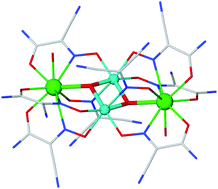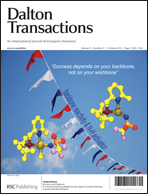The isostructural heterometallic complexes [LnIII2MnIII2O2(ccnm)6(dcnm)2(H2O)2] (Ln = Eu (1Eu), Gd (1Gd), Tb (1Tb), Er (1Er); ccnm = carbamoylcyanonitrosomethanide; dcnm = dicyanonitrosomethanide) have been synthesised and structurally characterised. The in situ transition metal promoted nucleophilic addition of water to dcnm, forming the derivative ligand ccnm, plays an essential role in cluster formation. The central [LnIII2MnIII2(O)2] moiety has a “butterfly” topology. The coordinated aqua ligands and the NH2 group of the ccnm ligands facilitate the formation of a range of hydrogen bonds with the lattice solvent and neighbouring clusters. Magnetic measurements generally reveal weak intracluster antiferromagnetic coupling, except for the large JMnMn value in 1Gd. There is some evidence for single molecule magnetic (SMM) behaviour in 1Er. Comparisons of the magnetic properties are made with other recently reported butterfly-type {LnIIIxMIII4−x (d-block)} clusters, x = 1, 2; M = Mn, Fe.

You have access to this article
 Please wait while we load your content...
Something went wrong. Try again?
Please wait while we load your content...
Something went wrong. Try again?


 Please wait while we load your content...
Please wait while we load your content...